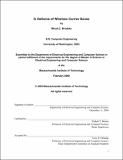In defense of wireless carrier sense
Author(s)
Brodsky, Micah Z. (Micah Zev)
DownloadFull printable version (849.4Kb)
Other Contributors
Massachusetts Institute of Technology. Dept. of Electrical Engineering and Computer Science.
Advisor
Robert T. Morris.
Terms of use
Metadata
Show full item recordAbstract
Carrier sense, or clear channel assessment (CCA), is widely used in wireless medium access control (MAC) protocols as the means to arbitrate access and regulate concurrency, striking a balance between interference protection and spatial reuse. Criticized widely in the literature, carrier sense has been subject to many replacement attempts with sophisticated and complex alternatives, yet it remains extremely popular. Is the search for a superior alternative justified? In this thesis, we develop a physically motivated theoretical model for average case carrier sense behavior in the two-sender case, based upon radio propagation theory and Shannon capacity. We argue from our model that common notions about carrier sense, such as the hidden and exposed terminal phenomena, are inherently misleading in the context of adaptive bitrate, casting in black and white terms effects that often cause only mild reduction in throughput. The frequency of severe misbehavior is low. We also demonstrate that it is possible to choose a fixed sense threshold which performs well across a wide range of scenarios, in large part due to the role of the noise floor. The noise floor has a significant effect on fairness as well. Using our model, we show that, when implemented well, average-case carrier sense performance is surprisingly close to optimal. We conclude with experimental results from our indoor 802.11 testbed, which corroborate these claims.
Description
Thesis (S.M.)--Massachusetts Institute of Technology, Dept. of Electrical Engineering and Computer Science, 2009. This electronic version was submitted by the student author. The certified thesis is available in the Institute Archives and Special Collections. Includes bibliographical references.
Date issued
2009Department
Massachusetts Institute of Technology. Department of Electrical Engineering and Computer SciencePublisher
Massachusetts Institute of Technology
Keywords
Electrical Engineering and Computer Science.